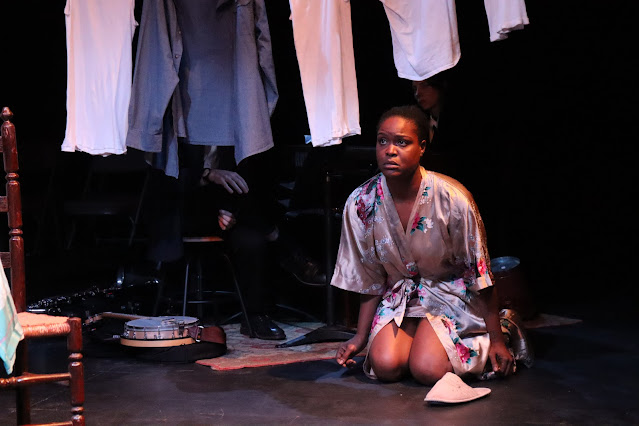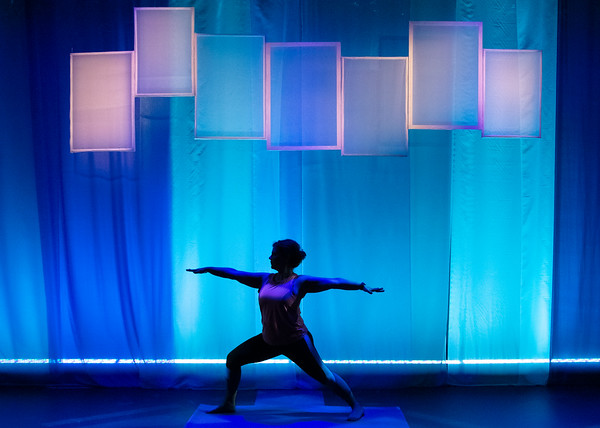Review: "The Notebook of Trigorin" Both Considers and Extends the Irondale Legacy
The Notebook of Trigorin
Written by Tennessee Williams
Directed by Jim Niesen
Presented by Irondale Ensemble Project at The Space at Irondale
85 South Oxford Street, Brooklyn. NYC
March 28-April 27, 2025
 |
| The Notebook of Trigorin. Photo courtesy of The PR Social |
The Notebook of Trigorin provides some lightly immersive touches even before the start of the show proper, further blurring the lines between the fictionalized and actual Irondale casts, and seating for a portion of the audience is available at tables on the periphery of performance area, further eroding distinctions between the inside and outside of the play world. As we transition seamlessly into the opening of the show, the cast are reminiscing about doing Uncle Vanya on East 4th Street, which leads to the two youngest actors, Jacqueline Joncas and Raphael Simon, revealing that they will be playing Nina and Constantine, respectively, in a soon-to-open production of The Notebook of Trigorin but are struggling with some aspects. During this conversation, questions arise of why the older cast members staged The Sea Gull in 1997, how the layers of worlds in the Williams adaptation work together, and the relative accessibility of Williams's and Chekhov's language, and the end result is that everyone starts in on a read-through of The Notebook of Trigorin. At first played very much as actors reading from scripts, the production bursts into bustling, noisy life as Simon performs Constantine's first lines, a sort of encapsulation of the way that production faultlessly blends a deconstructive visibility of stagecraft–including in Ken Rothchild's set design and the live musical accompaniment by Sam Day Harmet–and fourth-wall-breaking asides and metacommentary with engrossing naturalism in the performances both of the actors as the actors and the actors (sometimes holding scripts, sometimes not) as the characters in The Notebook of Trigorin.
 |
| The Notebook of Trigorin. Photo courtesy of The PR Social |
Among and intersecting with matters of love, questions of art–and theater especially–occupy the foreground, alongside considerations of age, and the generational gap between Nina and Kostya and the rest of the cast highlights the play's threads about the relationship of old and new forms of art and about aging, the denials it spurs, and the fears and frustrations of looking back over the accomplishments, or lack thereof, that populate one's life. The production also ensures that audiences don't miss the additional foregrounding of Irina and Nina–and the intersections of art and life–through Williams's having Trigorin speak of the women as his "notebooks." MacKenzie-Wood is a frequently hilarious Irina while also displaying genuine tenderness in at least one scene with Simon's Kostya and a potent mix of anger and affection during a fight with Cross's also frequently funny but nuanced Trigorin. Goodstein and Gilmore–who shines throughout as the unhappy, iconoclastic Masha, at one point playing both Masha and her mother for an extended exchange–deliver a similarly charged scene between Medvedenko and Masha in the play's latter stages. Greiss, who also doubles roles as Masha's father, renders Sorin and his fixation on the (art of the) past both humorous and sympathetic, and Gordon gives Dorn an appropriately shady charisma. As the representatives of the new generation, Simon and Joncas impressively incarnate Kostya's and Nina's respective descents into disillusionment. Significantly before those descents end up in rather contrasting places, an excellently staged moment when Kostya walks up and drops a murdered sea gull right between the feet of Trigorin and Nina as they are about to kiss acts as a memorable symbol of the intimacy and unpredictability that characterize this rousing, multidimensional production.
-John R. Ziegler and Leah Richards



Comments
Post a Comment